Rob Wickings's Blog, page 66
May 22, 2013
The Speakeasy Is GO!
A nervous, exciting and fulfilling day for Clive and I on Monday.
We convened at X&HTowers in sunny Caversham to yell the first brace of recordings for our new podcast The X&HT Speakeasy into my laptop. This was a first for me. I've been thinking about trying a podcast for a while, but never managed to pluck up the nerve. Clive, however, is a seasoned pro, after laying down a nested set of five 'casts for Frightfest with Mighty Stu Wright under the name of The Gruesome Twosome.
With the maturing of tools like Garageband, podcasting has become almost absurdly simple. It's really easy to put together a professional-sounding programme, complete with (if you feel the urge) whacky sound effects, studio applause and a full band. All from the comfort of your living room.
Or, in our case, my back bedroom. I live in a house with high ceilings and wooden floors–light and airy, but there's a lot of echo to deal with. The littlest bedroom (or as I now call it, Studio 1) has carpet and a lower roofline – a much more “dead” sounding room, and perfect for recording. I perched on the bed, put Clive on his podcasting stool, and plugged in.
We've recorded two 'casts for you this month. It's important to keep the content to one theme (something Excuses And Half Truths has never been able to manage–let's just say I have an eclectic approach to my curatorship of the space) so we decided to do a film and a music edition. So, what's in store?
In the film edition, we talk about Star Trek Into Darkness and The Great Gatsby, and consider how necessary any kind of reboot or reimagining is to a well-loved work of art. With the upcoming release of Ben Wheatley's A Field In England to every format available at once, we talk about how easy or otherwise it is to see arthouse films in blockbuster season. And we have DVD and download recommendations for you in a regular item we call Sofa Cinema.
The X&HT SPEAKEASY FILM EDITION
Sofa Cinema Links:
In the music Speakeasy, we're all over Daft Punk's new album Random Access Memories, and the National's Trouble Will Find Me. We look at geeky music rituals (particularly Clive's music notebooks), go on about Eurovision for slightly longer than necessary, and big up the tunes you should be listening to in our recommendation item, Download This!
THE X&HT SPEAKEASY MUSIC EDITION
Download This! Links:
Clive and I really hope you enjoy the Speakeasy. We've been talking about it for a while, and we're both nervously excited to see how it goes down. The next one will be on books and comics, dropping at the end of next month, with our second film Speakeasy to follow soon after.
Look out for us on iTunes soon, with YouTube links to come. For now, we're on Soundcloud, and of course live and direct on Excuses And Half Truths.
Speak to you soon!
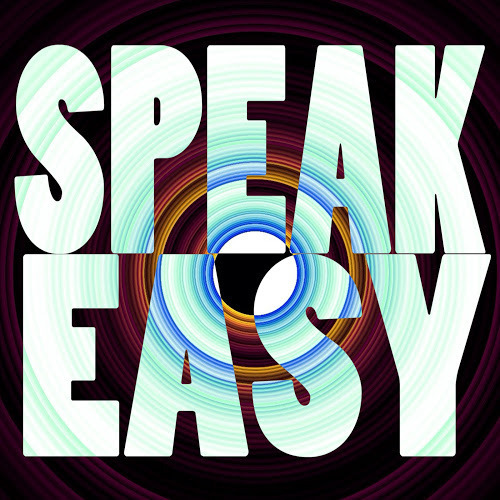


Trick Bag 2
An Everyday Carry post is the very definition of a look-at-me article. It's a simple notion: you post a picture of and talk about the items that you carry with you every day. The idea is that your belongings give an insight as to who you are.
There's obviously an egotistical element here, and normally I'd balk at being quite so revelatory. But as I have so many new followers, it's a way of getting to know each other.
I remain a writer without a definitive writing space. Over the past few years, I've trained myself to be able to write pretty much anywhere–as an example, this piece is being written in a hospital waiting room while I hang around for test results. In order to do that, I've developed a fairly pared down set of tools that allow me to set up shop wherever there's seat space.
The heart of the set up is my iPad, teamed with a Logitech Extrathin bluetooth keyboard. The two lock together magnetically, turning the tablet into a mini-laptop. Using stripped-down writing tools like Blogsy (for the blog, natch) and Daedalus, I can concentrate on wordcount without worrying about formatting. (still waiting on the iOS version of Scrivener). The battery on the iPad is good enough that I can write all day without needing a recharge. With all the benefits of wi-fi, I can and have posted for The View on trains, in cafes and pubs and even in the back seat of my brother-in-law's car.
For those times when I just need a little time away from the world, I plug in my Sennheiser CX300 noise-cancelling headphones and listen to a podcast or some music. There's nothing to them. They tuck into a tiny little snap-top pouch, and sound great. Like all my EDC, they're compact, discreet and eminently capable.
As a literaddict, my Kindle is never far away. It's not the newest or fanciest, but it does the job of an e-reader without fuss, and the battery life is brilliant. Other e-readers are available, of course, but until this one breaks there's no reason to change.
I always try to carry a notebook and writing implements. Sometimes it's just easier to scribble something down, or make a quick sketch. Field Notes notebooks are card-backed, small and stylish enough to go in the bag, although I'll never say no to a Moleskine. Along with that goes a Faber-Castell propelling pencil, a couple of Sharpies and a Bamboo stylus for the iPad.
Apart from keys (keyring from the Rijksmuseum in Amsterdam featuring Van Gogh's Skull With A Cigarette cos it's arty and rock n roll all at once, and a wee penknife/scissor combo from Leatherman which has got me out of trouble more times than I care to mention (not that sort of trouble)) and phone (iPhone 4, two and a half years old, well overdue for an upgrade hint hint) that's about it.
Apart from the bag I carry the whole shebang around in. Everything goes neatly into a Scaramanga Small Messenger Bag. Made from solid and ethically sourced leather, and built to last for a lifetime, this is the tote I've been after for a very long time. The leather is going to scuff up and soften beautifully over time. I want it to show that it's used with love; much like its owner.
Fasteners, importantly, are zips and mag closures–no nasty velcro for me, thank you. The build is incredibly sturdy, and finished with craft and care. With enough pockets and compartments to keep everything organised, it was delivered in a sweet little cloth bag that I've started using as an emergency shoppping bag. The Scaramanga was, if I'm honest, a bit on the pricy side, but I try to live by an ethical mantra when I'm shopping. Spend more, buy less, choose well. Frankly, my friends, I think I've chosen very well indeed.
So, that's my Everyday Carry, and that's more than enough from me today. I'd love to know what's in your daily go-kit. Feel free to share in the comments.


May 9, 2013
Announcing The X&HT Speakeasy!
An evening was had with Leading Man Clive last night. One of those big plan, wide focus, beer-fuelled discussions, an idea-cooker where great notions are born.
Of course, a lot of the time, those ideas wither away to a whisper of a ghost in the cold light of day. But every so often, something crops up and it won't go away, to the point that it seems silly not to try it, at least.
So, screw it, we're doing it.
Excuses And Half Truths is moving into podcasting.
The first episode will be recorded later this month. We're going to talk about anything and everything that comes to mind. There's a very good likelihood that we'll be discussing Star Trek Into Darkness, giving it a couple of weeks distance to be able to talk freely without fear of spoilers. We'll almost certainly be talking about the new Daft Punk album, which is out that day. As I've yet to even hear Stay Lucky, that could make for an interesting chat. Who knows, I might even drop a recipe or two.
And you can be involved too, Readership. Is there anything you want us to talk about? Is the prospect of hearing our dulcet tones ringing in your ears almost unbearably sensual? Let me know in the comments if there's a subject on your mind that you want us to air out on your behalf.
I'm opening up a fresh Twitter account this week dedicated to the blog and podcast, and we'll be taking questions live during the podcast through there as well. It's all very exciting, don't you think?
More news closer to the time, but for now, let us bask in the prospect of thrills to come, and the very real potential of a dreadful carcrash in the making. Readership, join Clive and I in this new adventure, something that we're calling, very simply…
The X&HT Speakeasy.
I wanted to call it The Excuse, until Clive wisely pointed out that it sounded like we were apologising for something. Whereas the Speakeasy will be intoxicating and barely legal.
Speak to you all soon.



May 8, 2013
Masked And Anonymous: Rob Saw Iron Man Three
If there's one thing I've learnt from many years of watching superhero movies, it's this: manage your disappointment.
They will never be as good as you think, never hit the same beats that the comics manage with such elegance, and never have you leaving the cinema thinking “You know what? I could happily have had another half-hour of that.”
I'd love to tell you that Shane Black's Iron Man Three bucks that trend. If anyone could, it's the guy that fundamentally rewrote the action movie with The Last Boy Scout, and with The Last Kiss Goodnight gave the genre its first credible female lead.
For the first twenty minutes, it feels like he's cracked it. Even better, it feels like he's done it on his terms. The voiceover, the wisecracks, the Christmas setting… goddamn, this feels like a Shane Black film. He and Robert Downey Jr have history, of course, working together on Kiss Kiss Bang Bang. There's a natural, relaxed, fluid feel about the dialogue and the setup. You believe that Tony Stark is a man losing the one thing he could always wear as armour if the Iron Man suit wasn't around… his self confidence.
Crippled with self-doubt and panic attacks after the events of The Avengers (Marvel's insistence on tying their franchises together must be really annoying if you're a casual movie-goer instead of a fan), Tony is struggling to find his place in a world that seems to be changing under his feet. His girl is running the family business, and he's spending all his time futzing with the suit. Meanwhile, a biological alternative is being field-tested under his feet, while a psychopathic terrorist called The Mandarin is blowing up bits of America. It's a tough time for our billionaire playboy, and he makes all the wrong decisions to get his life back on track. Before he knows it the house, the mansion and the girl are gone, and he has to reinvent himself to save the day.
There's a lot to like in Iron Man Three. Really, there is. It's well-cast and acted, with RDJ again not so much acting as inhabiting the manic yet haunted Tony Stark. There's a neat plot twist that I genuinely didn't see coming and some great dialogue. I'd dearly love to see Black's first draft script for the film, because I bet it's a stormer.
But the film suffers from all the problems of the third in a movie franchise. That first-draft script has been studio-noted into something that's twenty minutes over length, where all the yes-no plot beats in the third act are lined up like dominoes, where Tony is helped out by a precocious kid, gods help us. His anxiety problem isn't resolved. It conveniently goes away so that he can start flying around and punching people. The idea of the Extremis process, a new kind of super-soldier serum, being anything other than a speed and power upgrade (in the Warren Ellis and Adi Granov books that a lot of IM3 has been cribbed from, Tony uses Extremis as a way of interfacing with the suit, enabling it to be lighter and faster) is never explored. For Stark, one of the smartest men on the planet, to ignore this potential technological goldmine seems a bit short-sighted.
Any of the thoughtful or clever bits to Black's script are nearly drowned out in all the sound and fury that's an inevitable part of any blockbuster. This, fundamentally, is always going to be the problem with superhero movies. There's no room for the quiet stuff, for the unexpected moment of character development. Nuance is subsumed in the next big explosion. That's why I prefer the comics. There's room and time and budget to play around with plot and character that simply isn't available to the film-maker. It's great that Shane Black managed to wrangle as much time out of the suit as he could for Tony Stark. I have a feeling Robert Downey Jr. may have been a prime mover in that, wanting to get as much time with the character as he could.
You shouldn't walk into Iron Man Three expecting a radical reinvention of the superhero film. It's far too immured with the big Disney/Marvel track to tread a path of its own. It's perfectly enjoyable but exactly what you'd expect. Can we call a product a failure if it performs to specifications?


May 6, 2013
Bringing It All Back Home: Rob Saw The Place Beyond The Pines
 If you’ve been told that Derek Cianfrance’s new drama The Place Beyond The Pines is Drive 2, then I’m afraid you’ve been misinformed.
If you’ve been told that Derek Cianfrance’s new drama The Place Beyond The Pines is Drive 2, then I’m afraid you’ve been misinformed.
I guess you can see where the confusion has come from–just take a look at the trailer. Heavy on Ryan Gosling, brooding in ragged denim and fairground tatts, zazzing around upstate New York, brooding a bit more, robbing a bank… He’s lean, he’s mean, he’s got a chin like a plowshare.
Of course, you should take the sales pitch of any trailer with a large handful of salt. Make it a double handful in the case of The Place Beyond The Pines. Because what we have here is yer actual multigenerational drama, complete with police corruption, a love that will not die, and how a violent act can echo down the years and spark up again when you least expect it.
Let’s start with the Gosling, as that’s how the film begins: with a bravura five-minute shot tracking him through a fairground to the Globe Of Death ride that he rules with an almost unthinking cool. Right from the start, the comparisons with Drive start to unravel. The Driver of Nicholas Winding Refn’s film is an emotionless analogue. Stunt rider Luke wears his heart on his sleeve. The discovery that he has a son leads him to make bad and violent decisions, but they come from a place of love. He wants a family and a life, but can’t quite figure out how to get it. Hence the bank robberies. If he can’t be there for his ex-girlfriend and little boy, then he can at least provide for them.
But, as we all know, Readership, crime doesn’t pay. And just when you least expect it, something awful happens, and the focus shifts. Luke is out of the picture, and we’re in the world of Avery Cross, hero cop and, played with nervous energy by Bradley Cooper, a man who finds his integrity questioned at every turn, and his life entangled with Luke’s in unexpected way.
Another shift, and it’s fifteen years later. The connection between Luke and Avery deepens, as their two sons meet and find that the hidden history between them has the power to change their lives forever.
The Place Beyond The Pines has a scale and scope that’s rare in Hollywood films these days. It’s happy to tease out cross-connections between events that happen months, sometimes years apart. As a thoughtful treatise on notions of fate, consequence and way history always repeats itself, it works on a raft of different levels. It’s thrilling, moving and powerful. The standouts in an excellent cast are Bradley Cooper, who’s moving away from the slick smoothie role that he initially made his own into parts with a few more angles and rough patches, and Dale DeHaan, who gives Luke’s son Jason the right mix of vulnerability and barely contained fury.
I walked into this film with few expectations, and left nearly three hours later with my head spinning. The Place Beyond The Pines has one of the most expertly crafted scripts that I’ve seen in a long time, based around the boldest of conceits; the events that change our lives can be over in the time it takes to pull a trigger, yet echo down the years. Avery and Luke are never seen on camera together, and share one tiny scene. Yet they are bound by blood, and the need to do the right thing whatever the consequences. This is solid, inventive cinema that I urge you to find the time to see. As a precursor to Big Dumb Movie Season, The Place Beyond The Pines provides serious intellectual sustenance. Make a place in your schedule for it.


May 4, 2013
The Prisoner Of Soho: Rob Saw The Look Of Love
I have walked the streets of Soho for over twenty years. Of course I'm interested in a film about its King.
Soho is a small block in the heart of the West End, that is now home to theatres, posh eateries and bars. Once, it had a more interesting reputation–it was the place to go for strip clubs, adult cinemas and all manner of sleaze, corruption and vice. The vast majority of it was owned by impresario and pornographer Paul Raymond, at one point the richest man in England. The Look Of Love, directed by Michael Winterbottom from a script by Matt Greenhalgh, purports to tell his story.
Functionally, it's a standard biopic with a few stylistic whizbangs. We track Raymond's career from 1950's nudie shows, through to his 1970's heyday as a publishing magnate, before the inevitable fall and bittersweet coda. Winterbottom throws every trick in the book at us to keep things interesting, mimicking different film stocks, split screens, wacky wipes, magazine-style overlays. And nudity, of course. Lots and lots of nudity. The Look Of Love is rated as an 18, which makes sense given the BBFC's fear of anything remotely sexy. Nevertheless, it's all reasonably tasteful, and you even get to see Steve Coogan's bum, if that's your thing.
The trouble is, because it's at heart a standard biopic, it follows all the standard biopic rules. A rush through the early days, before we get to the meat of the tale. We're in and out of the sixties in a minute flat. The focus is squarely on the seventies, upping the groovy quotient, making the most of the hair and costumes. As our point of view narrows, we're drawn into the tale of Raymond and the three women in his life; his wife Jean, his daughter Debbie and his long-term girlfriend, the model Fiona Richmond.
And that's where I started to lose interest. The film starts to close in on itself, playing out in the tight bounds of Soho's narrow streets, in the ornate but sterile interiors of Raymond's houses and clubs. It becomes the story of the misfortunes of very rich people. There are tears and drugs and histrionics and tragedy, but none of it feels particularly deep or meaningful. Worse, it has an air of sheaudenfreude or hubris. We're here in the dark to enjoy the suffering of these people. I'm bothered a little by this, and wonder at the agenda at play.
Raymond was the richest man in Britain towards the end of his life, and he made his fortune through property. But no-one would be interested in a film about a wealthy property magnate and his difficult relationship with his daughter. It has to be about his life as a nude-show entrepreneur and publisher of softcore porn. The tragic end can somehow then feel appropriate–maybe even deserved. Casting Steve Coogan as Raymond puts another edge on the blade. That decision means that he can be portrayed as laughable, slightly pathetic, a puffed-up clown whose rise is balanced by an inevitable crash back to earth. This may not have been the intention, but the numerous Winterbottom/Coogan collaborations up to now have always locked onto a charismatic but deluded main character whose luck with women and success is tempered by the impression that he's something of a fool.
Coogan apart, who plays Coogan in a variety of funny wigs in moustaches, the performances are uniformally excellent, with a stand-out part for Imogen Poots as poor, doomed Debbie, falling to bits before our eyes. The Look Of Love is by no means a bad film. It's too well crafted for that. But I wanted to see a little bit more of Soho back in the day, and get a little more of the sleazy thrill of the place I remember when I first started working here. Maybe that's my fault for expecting more than a biopic of the King of Soho. The end result is far less free-wheeling and open than the trailers would lead you to expect. It's hermetic, almost airless, and really quite gloomy. Is this a by-product of the film's low budget, or perhaps another judgement on Raymond? He may have been rich and famous, but behold, here is a portrait of a man trapped in a quarter-mile of central London, fading quietly into a drug-fuelled doldrum. The sad pornographer, facing the inevitable consequence of his sleazy trade.
Again, am I reading too much into this? Am I seeing a quesy moral judgement at the heart of this film that's explicitly at odds with its supposed open-minded approach to Soho in the seventies? Most biopics have this character arc, after all. The major fall, the minor lift. Maybe all biopics contain a sickly glee at portraying the misfortunes of the rich and famous as part of their modus operandi. To me, though, The Look Of Love makes more of this than usual. It ties Raymond's career implicitly into his daughter's sad life and early death. Would she have been like this if Daddy didn't run nude theatre in the heart of the sleaziest neighbourhood in London?
Ultimately, The Look Of Love is a much more moralistic, far less open-minded film than I'd hoped for, that paints Raymond as a pathetic clown with identity issues. In the end, by attempting to paint him with the sleaze brush, it can't avoid splattering itself. That's a shame. There's a great history in these streets, and a biopic of Raymond would have been a great opportunity to frame a story with a much broader reach. Instead, we end up with the same old voyeuristic sniggering, with an agenda very much at odds with the glossy, air-brushed surface. You could argue that's a lot like Soho. I don't think that I could convince you otherwise, and The Look Of Love certainly doesn't bother. A wasted opportunity.


May 1, 2013
…And This Is Me
Here’s something for all you new followers out there. 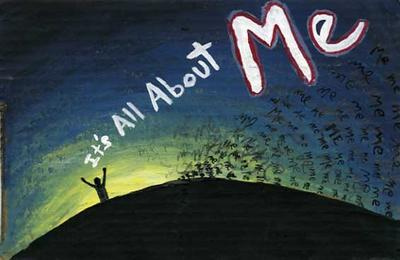 It’s gratifying to see a bunch of new followers arriving in 2013, and I figure it’s well overdue for a proper introduction. Therefore, even more than usual, a couple of posts this week are all about little old me.
It’s gratifying to see a bunch of new followers arriving in 2013, and I figure it’s well overdue for a proper introduction. Therefore, even more than usual, a couple of posts this week are all about little old me.
Now, much as I love to toot my own horn (quiet at the back there) in this case I’m lucky enough to have someone else to do it for me (I SAID QUIET!). Kate Atherton is a good friend and a talented blogger. Amongst her many accomplishments is For Winter Nights, a book blog that focusses on her passions; historical fiction, YA fantasy and SF. She very kindly sat me in a on of our favourite pubs in Oxford, bought me a beer, and persuaded me to start talking about myself. Never a hard job. She recorded and transcribed the lot, and the end results are up on her blog now.
If you want an insight into my writerly life, and my future plans, then I strongly suggest you go and give her your attention.
For Winters Nights: An Author Profile Of Rob Wickings


April 28, 2013
A Beating Heart Will Never Die: The Continuing Story Of Big Country
Always underestimated, Big Country have hit their 30th anniversary as a musical force that’s both reinvigorated and hungry.
[image error]Through the eighties and early nineties, Big Country were a big goddamn deal. They played at Live Aid, opened for the Stones over two tours and sold millions of records. They were loud, vibrant, passionate and powerful.
Then, in 2001, disaster struck. Lead singer and song-writer Stuart Adamson committed suicide – an act which buried the band. The remaining members had no interest at the time of carrying on with Big Country. Apart from greatest hits packages and live albums, all was silence.
But time heals, and as anniversaries rolled by, Bruce Watson, Mark Brzezecki and Tony Butler would get together and play. It was for for themselves than anything. Part of the healing process.
And as part of that, new songs started appearing. All of a sudden Big Country started to feel like a band again. Bruce Watson, the architect of the guitar sound that made them so distinctive, picked up the phone and called up a friend: Mike Peters of The Alarm. He had played with Big Country for the 25th anniversary shows. Now the question was, would he join as a full contributing member?
Peters didn’t think twice. He’s cited Adamson’s songs, especially the “Stay Alive” refrain of “In A Big Country” as a motivating force in his own battles with cancer. His anthemic, Celtic-tinged approach was a perfect fit. He joined, started supplying lyrics, and Big Country started recording their first album in 13 years.
Which brings us to Sub89, a rock venue in Reading, where TLC and I joined the faithful for the last gig of the UK leg of a tour promoting that new album, The Journey. With Bruce’s son Jamie joining the three-guitar attack, the line up on stage at Reading was close to the one that had played at Glasgow Barrowlands, their spiritual home, a few months before Stuart died. The one difference: the big yin on bass wearing a kilt: Derek Forbes, ex- Simple Minds, filling the breach after Tony Butler decided not to join the band on tour. Effectively, then 2013 Big Country is a celtic-rock supergroup.
And blow me down if they don’t make a thoroughly agreeable racket. Blasting into one of their biggest hits, Wonderland, it was immediately clear that this was no tired money-grubbing nostalgia trip. Big Country have punk roots, and they know how to take the roof off a room. Mark Brzezecki’s drums have always been complex and punishing, a torrent of fills and smashes that have the unstoppable energy of boulders flung down a staircase. Watson pere et fils bring that distinctive guitar sound and punch it out with force and skill. The genius move is in having Mike Peters front the band. He’s a showman, a raconteur, and to my mind fits into that fine musical tradition, the Welsh belter. Think Tom Jones with a battered acoustic guitar, Kelley Jones of the Stereophonics with a bit more soul.
Yeah, sure, they’re playing small clubs to an audience that knows and loves them. They’re preaching to the choir. But I wasn’t expecting the band to care this much, to put so much of themselves into the performance. Big Country are a band that have found their voice again, their purpose. It’s a real treat to see musicians of this calibre and stature play to a small crowd in a provincial town with such passion and sheer joy. Big Country are back: very loud, very proud, a living testament to the power of faith, reconciliation and healing.
The Journey is available now wherever you buy your music from.
The Journey tour rolls on until July, taking in Europe and America. They have one last UK gig in June, at the Forum. Well worth a look.
Big Country: The Journey Starts Here!


April 21, 2013
Thoughts On Record Store Day 2013
Soho on a Saturday morning is usually a quietly hungover place. Not on the 20th of April. 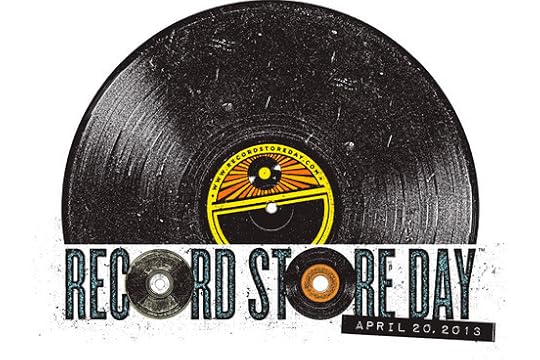
That’s the day set aside to show a little love to that most beleaguered of institutions: the great British record shop. Special events, one-day-only releases, live DJ and band sets; a ton of enticements, all designed to drag the music fan away from their Spotifys and download sites, out blinking into the sunshine and off to buy some physical product.
I wasn’t expecting that the event would be so popular. Soho, my workplace for the last 20-odd years, has a decent supply of record shops, from indie powerhouse Sister Ray to funk-soul moonbase Sounds Of The Universe. I shouldn’t have been so surprised, then, that they’d team up to make a big noise about the day. Nevertheless, the sheer scale of things was a bit discombobulating.
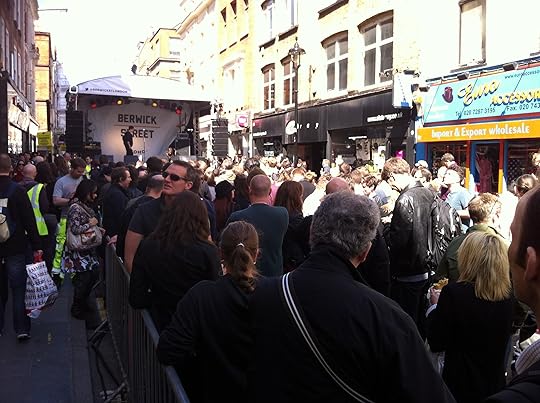
Sister Ray just visible through the crowds on the right…
The queues for Sister Ray stretched right around the block from Berwick Street and down past my workplace on Wardour Street at 8am, an hour before the shop opened. When I popped out for lunch to soak up the atmosphere, I was presented with Soho in gridlock. The local pubs were overflowing, the food stalls on Berwick Street market were doing great business, and joined by enterprising pop-ups from Soul Jazz records and the Museum Of Soho. The local Cass Art was getting people to draw their favourite record covers (strangely they weren’t down with me recreating Reek Of Putrifaction by Carcass). A music marquee had been set up, with bands pumping out good vibrations through the day. With beautiful clear blue skies overhead, the old place suddenly seemed cool and exciting again.
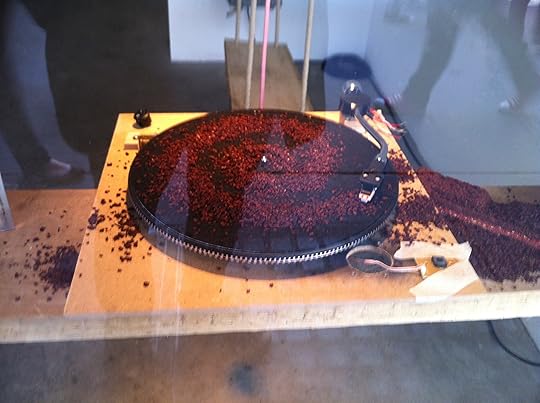
Rock music. BWAAHAHAHAHAaa
The downside? Well, there was no way into Sister Ray to pick up any of the heavily buzzed-about releases–the queues were still halfway up D’arblay Street at 2 in the afternoon. As the inestimable Unklerupert pointed out on Twitter, a lot of the people there were probably not the music fans they seemed:
Well it seems a lot of Bowie "fans" have fallen on hard times very quickly today and having to sell their #RSD13 7"s ebay.co.uk/sch/i.html?_tr…—
(@unklerupert) April 20, 2013
It was, bizarrely, too busy to comfortably browse for music–surely the prime pleasure inherent in wandering into a record shop on a sunny Saturday afternoon. While I don’t want to put a downer on an event that was quite clearly a raging success, it would be nice to see even a quarter of the business BlackMarket, Phonica and the like saw yesterday on every Saturday of the year. Having to make a big deal out of something that should be a simple pleasure only really highlights the parlous state many of these brilliant shops find themselves in these days.
That being said, it was nice to see that Soho is still capable of generating a bit of buzz, and it’s a gentle reminder to me that I need to get my turntable fixed and spinning platters again.
Meanwhile, in Bristol, DocoDom summed the day up nicely with a shot he took in Rise. Here’s to the next one!

Miles of Smiles


April 18, 2013
A Time To Shine And A Time To Die: Rob Read The Shining Girls
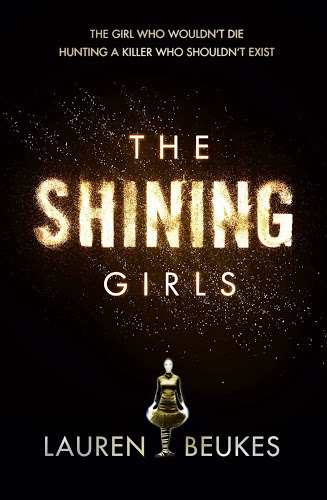
Harper Curtis is a serial killer. He focuses on girls with a particular quality; for him, they shine. He is drawn to them, like a ship to a lighthouse. There aren't many of these girls. They are scattered across the 20th Century like rare jewels. It's fortunate, then, that Harper has stumbled on a way to travel through time. No-one is able to stop him. In fact, no-one can see the pattern. No-one, perhaps, except perhaps Kirby Mazrachi, the only one of Harper's Shining Girls to survive his attentions…
Lauren Beukes, award-winning author of Zoo City, has crafted a story that skips around genres as easily as Harper dances through the decades. Part horror, part fantasy, part thriller, The Shining Girls is a bracingly original take on the serial killer genre. Intense, bloody, yet moving, the story brings the Girls to vivid life as Harper visits them, once as children, with a gift, and later as adults, with a knife. The sense of loss, the sense of waste that comes as Harper snuffs out their inner light to satisfy his ravenous, unfathomable needs gives the book a depth above and beyond your average slasher book. As he roams the 20th century, Harper becomes less like a killer, and more like a plague. Just as heartless. Just as merciless.
He is a monster, of course, and driven by urges that distance him from us even further. And yet, Beukes instills Harper with a sense of pathos. He is unmoored from any kind of human connection. Even the passage of history shrugs him off, as we come to realise that time itself–or at least the time-travelling house that has become his home–has plans for him.
The Shining Girls is boldly inventive, fearlessly intelligent and bracingly original. Along with Michael Marshall, who made his name with a trio of mind-bending SF novels before moving into thrillers, Lauren Beukes is showing that it takes a writer with a taste for the fantastical to twist the serial killer genre into something new and exciting.
The Shining Girls is released on April 25th by HarperCollins, and is available for pre-order through all good bookshops.





